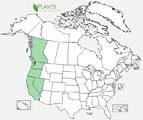 |
|||
 |
 |
 |
|
 |
|||
From a horticultural and restoration perspective, Poison oak (Toxicodendron diversilobum) is a nearly ideal plant. It is a vigorous, beautiful plant that grows well in an amazing diversity of habitats. It is found in oak woodlands, redwood forests, coastal scrub, chaparral, grasslands, coastal bluffs and more. It seems to be everywhere. It spreads by rhizomes, and can help with erosion control. It is one of the few native plants with vibrant fall color.
But it has an Achilles heel. It produces urushiol, the rash inducing chemical that plagues so many people. Poison oak turns from a highly desirable plant into something of a public menace. Our crew has spent many hours on poison oak eradication.
If not for urushiol, this would have been one of the most popular plants for restoration and landscaping. Because of it, the plant is utterly useless.
For of all sad words of tongue or pen,
The saddest are these: "It might have been!"
- John Greenleaf Whittier
Poison Oak
Toxicodendron diversilobum
Native Plant Species
Cronquist System |
|
Order: |
Sapindales |
Family: |
|
Genus: |
|
APG System |
|
Order: |
Sapindales |
Family: |
Anacardiaceae |
Genus: |
Toxicodendron |
Description |
|||
Description: |
Toxicodendron diversiloba is a deciduous shrub. It generally grows to 4 or 5 feet in height. It can rarely grow as a vine that attaches to trees by means of many small tendrils. When it does this, it closely resembles its cousin Poison ivy (Toxicodendron radicans). |
||
Branching: |
Opposite. |
||
Leaves: |
Pinnately compound leaves, with three leaflets per leaf. |
||
Flowers: |
Flowers are in panicles or racemes. They tend to stand upward at the ends of branches. |
||
Fruit: |
Fruits are drupes with a white or off-white color. |
||
Plant Relationships |
|||
Related California Species: |
(None) |
||
Related Exotic Species: |
Toxicodendron radicans |
Poison ivy |
|
Growing Conditions |
|||
Natural Range and Habitat: |
Poison oak grows from British Columbia to Baja California. |
||
Sun and Exposure: |
Poison oak tolerates partial shade, but grows poorly in deep shade. It grows best in full sun. |
||
Soil and Moisture Requirements: |
Poison grows best in deep soil,where the roots can readily find a stable water supply. It is remarkable, however, in the diversity of soil types where it will thrive. |
||
Horticulture and Restoration |
|||
Wildlife Habitat: |
Although up to 30% of humans are sensitive to poison oak, most wildlife are not. This plant is widely used as deer browse and as nesting habitat for birds. |
||
Restoration: |
Cannot be used, because of skin rashes. |
||
Uses in Landscaping: |
Cannot be used, because of skin rashes. |
||
Back to start page
